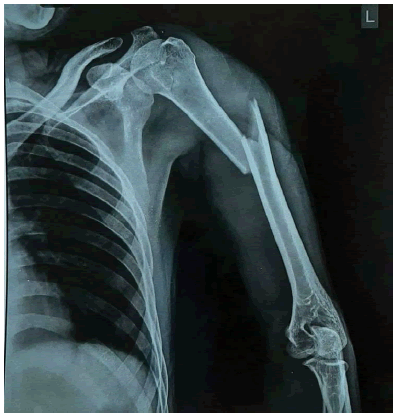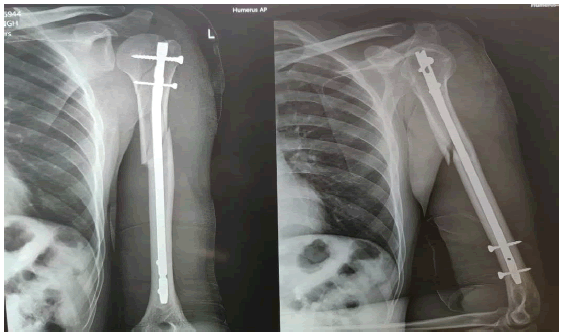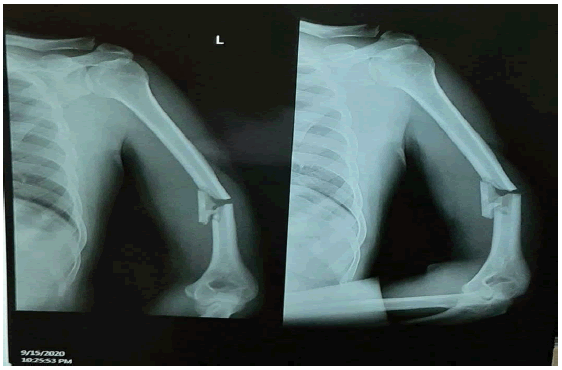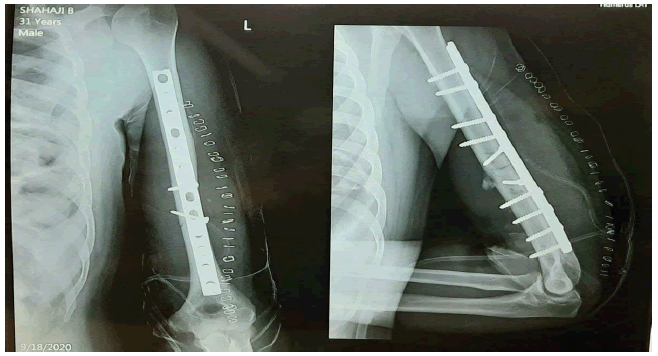A descriptive study of nailing versus plating in humerus shaft fractures
Received: 07-Aug-2021 Accepted Date: Aug 30, 2021 ; Published: 10-Sep-2021, DOI: 10.37532/1897-2276.2021.16(1).36
This open-access article is distributed under the terms of the Creative Commons Attribution Non-Commercial License (CC BY-NC) (http://creativecommons.org/licenses/by-nc/4.0/), which permits reuse, distribution and reproduction of the article, provided that the original work is properly cited and the reuse is restricted to noncommercial purposes. For commercial reuse, contact reprints@pulsus.com
Abstract
Introduction: Humeral shaft fracture accounts for about 3% of all Humeral fractures, hence orthopaedic surgeons are commonly encountered with these types of fractures. There is a continuous evolution of treatment methods for these injuries in both non-operative and as well as operative management.
Materials and Methods: This was a retrospective study conducted at our institution from June 2019 to June 2021. Both antegrade interlocking nail fixation and dynamic compression plating were done for the treatment of acute humeral shaft fractures.
Results: Approximately seventy percent (17 out of 24) patients underwent interlocking nails and had fair to excellent results, while ninety-four percent of patients (17 out of 18) who underwent plating group had a comparable outcome.
Conclusion: Both modalities of treatment are beneficial depending upon the case. Interlocking nails in the treatment of closed humeral shaft fractures is inferior by enlarging to Plating. In plating, union is also earlier.
Keywords
humerus shaft fracture, interlocking nail, plating
Introduction
Humeral shaft fracture accounts for about 3% of all humeral fractures, hence orthopaedic surgeons are commonly encountered with these types of fractures [1]. There is a continuous evolution of treatment methods for these injuries in both non-operative and as well as operative management. Most of them are treated best non-operatively, but in certain situations, operative options are the only option [2-4]. Recent advances in internal fixation techniques are quite encouraging. Also, instrumentation has widened the expansion of surgical indications of these fractures and also created a dilemma for choosing the procedure.
Materials and Methods
This was a retrospective study conducted at our institution from June 2019 to June 2021. Here both antegrade interlocking nail fixation and dynamic compression plating were done for the treatment of acute humeral shaft fractures. 42 subjects were included in our study. 24 patients underwent interlocking nailing while 18 underwent plating for humeral shaft fractures.
INCLUSION CRITERIA
• Patients with Humerus Mid Shaft Fractures
• Patients above 18 years of age
EXCLUSION CRITERIA
• Below 18 years
• Within 4 cm of proximal and distal end of humerus fractures
• Segmental fractures
• Pathological fractures
ETHICAL CLEARANCE
Ethical clearance was obtained by the Institutional Ethical Committee.
PRE-OPERATIVE ASSESSMENT
Clinical and radiological assessment was done mainly in all patients.
SURGICAL TECHNIQUE
Intramedullary nailing of the humerus shaft fracture was done by the Standard technique. For plating, a 3.5 mm dynamic compression plate was used according to the width of the bone according to AO principles (Figures 1-4).
POST-OPERATIVE FOLLOW-UP
Immediate postoperative shoulder and elbow exercises and radiographs at regular intervals were done in the post-operative period in all the patients.
For comparing the postoperative results of interlocking nailing and plating Rodriguez-Merchan criteria was used. Scores were based on shoulder movement, elbow movements, pain and disability after the procedure and the result was ranked as excellent, good, fair and poor (Table 1). A lower category was selected to classify the outcome in case any two different criteria fell into separate categories.
| Ranking | Elbow joint | Shoulder joint | Pain | Disability |
|---|---|---|---|---|
| Excellent | 5°Extension | Full range of movement | Nil | Nil |
| 130°Flexion | ||||
| Good | 15°Extension | <10% loss of ROM | Minimal | Minimal |
| 120°Flexion | ||||
| Fair | 30°Extension | 10%-30% loss of ROM | With ROM of affected joint | Moderate |
| 110°Flexion | ||||
| Poor | 40°Extension | >30% loss of ROM | Variable | Severe |
| 90°Flexion |
Table 1. Criteria for evaluating functional results (Movement, pain and disability)
Results
DEMOGRAPHICS
Age distribution was found between 14-73 years. Maximum incidence was observed in age groups 31-40 years followed by 21-30 (Table 2). Male preponderance was found in 29 (68%) patients. Road traffic accidents were in the top 35 (82%) then was domestic and other causes. A3 and B2 of AO classification were used for all the fractures. And 2/3 (62%) were in the middle third of the humerus of the shaft. Medical problems which were found associated with this included high blood pressure in 6 individuals, ischemic heart disease in 9 individuals and diabetes mellitus in 5 individuals.
| Age (Years) | Frequency (n=42) | Percentage |
|---|---|---|
| 11-20 | 1 | 2.2 |
| 21-30 | 10 | 23.8 |
| 31-40 | 18 | 41.6 |
| 41-50 | 7 | 16.6 |
| 51-60 | 5 | 11.9 |
| 61-70 | 1 | 2.2 |
| 71-80 | 0 | 0 |
Table 2. Age distribution
INDICATIONS
Failure of fracture with unacceptable were the reasons for operative intervention in more than half of the patients in our study (Table 3).
| Indications | Frequency (n=42) | Percentage |
|---|---|---|
| Comminuted humeral fractures | 15 | 36.1 |
| Unreduced fractures | 23 | 57 |
| Displacement of fracture reduction managed conservatively (before 6 weeks) | 2 | 4.7 |
| Open fractures | 1 | 2.2 |
| Pathological fractures | 0 | 0 |
| Humerus fractures with other associated fractures | 1 | 1.1 |
Table 3. Indications for operative management
Tables 4 and 5 indicate complications.
| Complications | Frequency (n=24) | Percentage |
|---|---|---|
| lesion at insertion point | 0 | 0 |
| Splintering of fracture site | 1 | 5 |
| Damage to radial nerve | 0 | 0 |
| Infective causes | 1 | 5 |
| Delayed union (more than 16 weeks) | 9 | 50 |
| Non-union | 1 | 5 |
| Shoulder stiffness | 2 | 10 |
Table 4. Complications of interlocking nail
| Complications | Frequency (n=18) | Percentage |
|---|---|---|
| Infective causes | 1 | 5.5 |
| Damage to radial nerve | 1 | 5.5 |
| Delayed union (>16 weeks) | 4 | 22.2 |
| Non-union | 1 | 5.5 |
| Breakage of implant | 0 | 0 |
Table 5. Complications of plating
TIME FOR UNION
Union in less than 16 weeks was found in 50% of interlocking nail patients and 72.2% of plating patients (Tables 6 and 7). One case of interlocking nailing had non-union (5%) implant failure, which was treated conservatively. One case of non-union in plating (5.5%) was found and was treated by revision surgery.
| Time taken for radiological union | Frequency (n=24) | Percentage |
|---|---|---|
| Less than 16 weeks | 12 | 50 |
| More than 16 weeks | 12 | 50 |
Table 6. Radiological union in case of interlocking nail
| Time is taken for union | Frequency (n=18) | Percentage |
|---|---|---|
| Less than 16 weeks | 13 | 72.2 |
| More than 16 weeks | 5 | 27.7 |
Table 7. Radiological union in case of plating
Approximately seventy percent (17 out of 24) patients underwent interlocking nail had fair to excellent results, while ninety-four percent approximately (17 out of 18) patients underwent plating group had comparable outcome (Tables 8 and 9).
| Outcome (Rodriguez–Merchan criteria) | Frequency (n=24) | Percentage |
|---|---|---|
| Excellent | 4 | 16.6 |
| Good | 9 | 37.5 |
| Fair | 4 | 16.6 |
| Poor | 2 | 10 |
Table 8. Results of interlocking nail
| Outcome (Rodriguez–Merchan criteria) | Frequency (n=18) | Percentage |
|---|---|---|
| Excellent | 5 | 27.7 |
| Good | 12 | 66.6 |
| Fair | 0 | 0 |
| Poor | 1 | 5.5 |
Table 9. Results of plating
Discussion
Surgical management of humeral shaft fractures has the following indications: (a) unsatisfactory alignment or reduction by non-operative methods, (b) humeral fracture with radial nerve palsy occurred after manipulation or application of a cast, (c) pathological fracture,(d) segmental fracture, (e) fracture with major vascular injuries, (f) associated injuries requiring early mobilisation (g) floating elbow and (viii) polytrauma [2,4-7].
Humeral shaft fractures most commonly occur in males in the third decade as road traffic accident was [1]. Variations in epidemiological features of humeral shaft fractures in various geographical areas have been found [1,4,7]. Internal fixation methods can be plating or intramedullary, among many operative interventions for humerus shaft fractures.
In segmental and pathological fractures Interlocking nailing is preferable in communicated, pathological and segmental fractures while plating is preferred if radial nerve exploration is contemplated [1]. In Conventional plating techniques, open reduction of fracture is done through an extensive surgical approach, while with minimally invasive plating encouraging results have been reported recently [8-10].
If there are humeral shaft fractures and open injuries external fixation is done [4]. Infection, non-union and radial nerve palsy are common complications of the plating group [6, 11, 12].
A meta-analysis from pooled data shows that results of open reduction with plate fixation did not pose higher risks of non-union, infective etiology, or injury of radial nerve [13]. Intramedullary techniques increase the risk of restriction of shoulder movements and delayed union. [6,9,12-15]. Antegrade interlocking nails impairs shoulder function because of intrusion for proximal migration of nail, adhesive capsulitis, rotator cuff injury or idiopathic cause [15-17]. This can be reduced by the use of retrograde technique but here fracture at the insertion point and risk of elbow movement restriction will remain [6, 11, 16].
Conclusion
Increased incidence of elbow stiffness with the plating group is also reported [15]. In our study, excellent and good results in patients whounderwent plating is higher as is seen in other studies also [9, 17]. No difference in the rate of union and functional outcome was found between the two groups but in interlocking patients, a shorter union time has been reported in a recent study [16].
Both modalities of treatment are beneficial depending upon the case. Interlocking nails in treatment of closed humeral shaft fractures is inferior by enlarge to Plating. In plating reunion is also earlier.
REFERENCES
- Tsai C.H., Fong Y.C., Chen Y.H., et al.: The epidemiology of traumatic humeral shaft fractures in Taiwan. Int Orthop. 2009;33:463-467.
- Foster R.J., Dixon G.L., Jr., Bach A.W., et al.: Internal fixation of fractures and non-unions of the humeral shaft. Indications and results in a multi-center study. J Bone Joint Surg Am. 1985;67:857-864.
- Sarmiento A., Kinman P.B., Galvin E.G., et al.: Functional bracing of fractures of the shaft of the humerus. J Bone Joint Surg Am. 1977;59:596-601.
- Sarmiento A., Waddell J.P., Latta L.L.: Diaphyseal humeral fractures: Treatment options. Instr Course Lect. 2002;51:257-269.
- Bell M.J., Beauchamp C.G., Kellam J.K., et al.: The results of plating humeral shaft fractures in patients with multiple injuries. The Sunnybrook experience. J Bone Joint Surg Br. 1985;67:293-296.
- Hall R.F., Pankovich A.M.: Ender nailing of acute fractures of the humerus. A study of closed fixation by intramedullary nails without reaming. J Bone Joint Surg Am. 1987;69:558-567.
- Klenerman L.: Fractures of the shaft of the humerus. J Bone Joint Surg Br. 1966;48:105-111.
- An Z., Zeng B., He X., et al.: Plating osteosynthesis of mid-distal humeral shaft fractures: minimally invasive versus conventional open reduction technique. Int Orthop. 2010;34:131-135.
- Ji F., Tong D., Tang H., et al.: Minimally invasive percutaneous plate osteosynthesis (MIPPO) technique applied in the treatment of humeral shaft distal fractures through a lateral approach. Int Orthop. 2009;33:543-547.
- Livani B., Belangero W., Andrade K., et al.: Is MIPO in humeral shaft fractures really safe? Postoperative ultrasonographic evaluation. Int Orthop. 2009;33:1719-1723.
- Brumback R.J., Bosse M.J., Poka A., et al.: Intramedullary stabilization of humeral shaft fractures in patients with multiple trauma. J Bone Joint Surg Am. 1986;68:960-970.
- Rodríguez-Merchán E.C.: Compression plating versus Hackethal nailing in closed humeral shaft fractures failing nonoperative reduction. J Orthop Trauma. 1995;9:194-197.
- Bhandari M., Devereaux P.J., McKee M.D., et al.: Compression plating versus intramedullary nailing of humeral shaft fractures-a meta-analysis. Acta Orthop. 2006;77:279-284.
- Chapman J.R., Henley M.B., Agel J., et al.: Randomized prospective study of humeral shaft fracture fixation: Intramedullary nails versus plates. J Orthop Trauma. 2000;14:162-166.
- Changulani M., Jain U.K., Keswani T.: Comparison of the use of the humerus intramedullary nail and dynamic compression plate for the management of diaphyseal fractures of the humerus. A randomised controlled study. Int Orthop. 2007;31:391-395.
- Raghavendra S., Bhalodiya H.P.: Internal fixation of fractures of the shaft of the humerus by dynamic compression plate or intramedullary nail: A prospective study. Indian J Orthop. 2007;41:214-218.
- Stern P.J., Mattingly D.A., Pomeroy D.L., et al.: Intramedullary fixation of humeral shaft fractures. J Bone Joint Surg Am. 1984;66:639-646.







 Journal of Orthopaedics Trauma Surgery and Related Research a publication of Polish Society, is a peer-reviewed online journal with quaterly print on demand compilation of issues published.
Journal of Orthopaedics Trauma Surgery and Related Research a publication of Polish Society, is a peer-reviewed online journal with quaterly print on demand compilation of issues published.